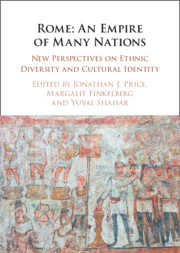Book contents
- Rome: An Empire of Many Nations
- Reviews
- Rome: An Empire of Many Nations
- Copyright page
- Contents
- Figures
- Contributors
- Acknowledgments
- Abbreviations
- Introduction
- Part I Ethnicity and Identity in the Roman Empire
- 1 From Rome to Constantinople
- 2 The Imperial Senate
- 3 Ethnic Types and Stereotypes in Ancient Latin Idioms
- 4 Keti, Son of Maswalat
- Part II Culture and Identity in the Roman Empire
- Part III Ethnicity and Identity in the Roman Empire
- Part IV Iudaea/Palaestina
- Bibliography
- General Index
- Index Locorum
1 - From Rome to Constantinople
from Part I - Ethnicity and Identity in the Roman Empire
- Rome: An Empire of Many Nations
- Reviews
- Rome: An Empire of Many Nations
- Copyright page
- Contents
- Figures
- Contributors
- Acknowledgments
- Abbreviations
- Introduction
- Part I Ethnicity and Identity in the Roman Empire
- 1 From Rome to Constantinople
- 2 The Imperial Senate
- 3 Ethnic Types and Stereotypes in Ancient Latin Idioms
- 4 Keti, Son of Maswalat
- Part II Culture and Identity in the Roman Empire
- Part III Ethnicity and Identity in the Roman Empire
- Part IV Iudaea/Palaestina
- Bibliography
- General Index
- Index Locorum
Summary
The status of Rome vis-à-vis the Roman empire is analyzed. Fears that it might be replaced and the imperial capital would be transferred are reported from the first century BC onward. Foundation myths suggested that Rome originated in the East, in Troy, and it was suspected that the capital might move back to the East. These suspicions did not materialize for centuries but became reality under Constantine with the refoundation of Byzantium as Constantinople. The choice of Constantinople as (eastern) capital may not have been a matter of course from the start. Other cities seem to have been considered first, and it is not certain why it was chosen. Furthermore, there is no contemporary evidence that Constantine always conceived his new foundation as the eastern capital of the empire, or that he intended that it should replace Rome. Claims, made first by Christian authors, that Constantine’s city was conceived from the start as the new or second Rome and also as a purely Christian city cannot be confirmed. The city actually took time to develop into an imperial capital. The city became the undisputed centre of the late Roman empire only in the reign of Theodosius I.
- Type
- Chapter
- Information
- Rome: An Empire of Many NationsNew Perspectives on Ethnic Diversity and Cultural Identity, pp. 17 - 28Publisher: Cambridge University PressPrint publication year: 2021



